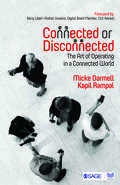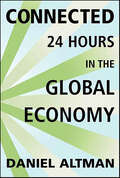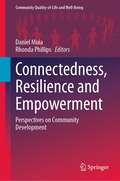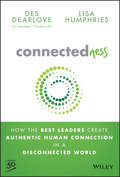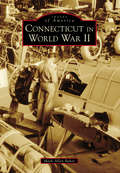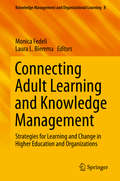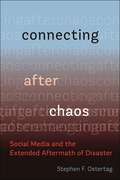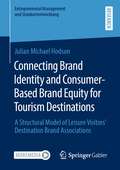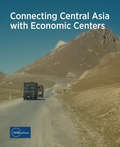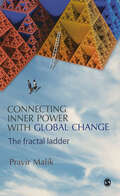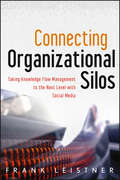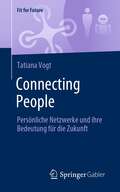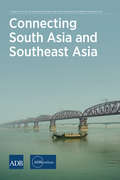- Table View
- List View
Connected or Disconnected: The Art of Operating in a Connected World
by Micke Darmell Kapil RampalThe promise of a connected world… Democratization, strengthened personal relationships, and all the knowledge in the world available at your fingertips, more or less for free. And all this regardless of whether you are in India, China, Chile, or Chad. Indeed, the connected world has changed the premise of what it means to be human, and it will continue to impact lives at a rapidly growing pace in the years to come, both on a personal and professional level. Many organizations take advantage of the “anytime, anywhere office” without accepting responsibility for the flip side. On an individual level we have accepted the promise of the connected world and headed into this new way of living without reflecting and acting upon its ramifications. This book will advise you on how to handle the challenges constant connectedness poses to our wellbeing—sleeping patterns, close relations, work-life balance, and parenting. It does not discuss whether this is a threat or an opportunity for us, because it is both. What we really need to start discussing is how to handle the new challenges that constant connection brings and when to step out of it in order to tend to our wellbeing. The book concludes that while accepting that we live in a constantly connected world, we at times need to disconnect to reconnect with the world.
Connected: 24 Hours in the Global Economy
by Daniel AltmanWhat if you could look behind the headlines of the global economy to see how it really worked? Instead of listening to pundits, politicians, and protestors, you could see firsthand how everyone from migrant workers to central bank governors lived their lives. Then you could decide for yourself where the big trends were heading.Now you can. Connected: 24 Hours in the Global Economy isn't another polemic for or against globalization. Daniel Altman takes you on a whirlwind journey through more than a dozen cities, gathering points of view from moguls, ministers, and the men and women on the street. At each stop, you'll hear how the world's workers played their parts in the events of a single day. Starting with their stories, related in their own words, you'll take on pressing questions in new ways: Can poor countries become rich too quickly? Can corruption ever be a good thing? Do companies need crises in order to stay competitive? What determines the global economic pecking order? Most important, you'll learn how the billions of decisions made by individuals can and do change the future.Connected: 24 Hours in the Global Economy is part travel guide, part owner's manual—an absorbing, accessible, and essential road map for every citizen of the global economy in the twenty-first century.
Connectedness and Contagion: Protecting the Financial System from Panics
by Hal S. ScottThe Dodd--Frank Act of 2010 was intended to reform financial policies in order to prevent another massive crisis such as the financial meltdown of 2008. Dodd--Frank is largely premised on the diagnosis that connectedness was the major problem in that crisis -- that is, that financial institutions were overexposed to one another, resulting in a possible chain reaction of failures. In this book, Hal Scott argues that it is not connectedness but contagion that is the most significant element of systemic risk facing the financial system. Contagion is an indiscriminate run by short-term creditors of financial institutions that can render otherwise solvent institutions insolvent. It poses a serious risk because, as Scott explains, our financial system still depends on approximately $7.4 to $8.2 trillion of runnable and uninsured short-term liabilities, 60 percent of which are held by nonbanks. Scott argues that efforts by the Federal Reserve, the FDIC, and the Treasury to stop the contagion that exploded after the bankruptcy of Lehman Brothers lessened the economic damage. And yet Congress, spurred by the public's aversion to bailouts, has dramatically weakened the power of the government to respond to contagion, including limitations on the Fed's powers as a lender of last resort. Offering uniquely detailed forensic analyses of the Lehman Brothers and AIG failures, and suggesting alternative regulatory approaches, Scott makes the case that we need to restore and strengthen our weapons for fighting contagion.
Connectedness and Contagion: Protecting the Financial System from Panics
by Hal S. ScottAn argument that contagion is the most significant risk facing the financial system and that Dodd¬Frank has reduced the government's ability to respond effectively.The Dodd–Frank Act of 2010 was intended to reform financial policies in order to prevent another massive crisis such as the financial meltdown of 2008. Dodd–Frank is largely premised on the diagnosis that connectedness was the major problem in that crisis—that is, that financial institutions were overexposed to one another, resulting in a possible chain reaction of failures. In this book, Hal Scott argues that it is not connectedness but contagion that is the most significant element of systemic risk facing the financial system. Contagion is an indiscriminate run by short-term creditors of financial institutions that can render otherwise solvent institutions insolvent. It poses a serious risk because, as Scott explains, our financial system still depends on approximately $7.4 to $8.2 trillion of runnable and uninsured short-term liabilities, 60 percent of which are held by nonbanks.Scott argues that efforts by the Federal Reserve, the FDIC, and the Treasury to stop the contagion that exploded after the bankruptcy of Lehman Brothers lessened the economic damage. And yet Congress, spurred by the public's aversion to bailouts, has dramatically weakened the power of the government to respond to contagion, including limitations on the Fed's powers as a lender of last resort. Offering uniquely detailed forensic analyses of the Lehman Brothers and AIG failures, and suggesting alternative regulatory approaches, Scott makes the case that we need to restore and strengthen our weapons for fighting contagion.
Connectedness, Resilience and Empowerment: Perspectives on Community Development (Community Quality-of-Life and Well-Being)
by Rhonda Phillips Daniel MuiaThis book discusses how aspects of connectedness, resilience and empowerment are intertwined in community development processes. It explicitly brings together these elements in the context of community development and well-being, helping foster an understanding of how each influences the other. With chapters contributed by scholars from around the globe, this volume provides insights into how these elements of community influence and support the quality of life of communities. While several of the chapters address the foundational and theoretical bases of community development as well as community well-being, others address topical and emergent areas of interest in community development practice and scholarship. Underscoring the chapters is an awareness of the importance of the community spirit, which is the voice and agency of people coming together to encourage social transformation. A key element of the book is also to help foster change for the better in communities. This book is of interest to researchers and professionals working in the area of community engagement and development, particularly those in resource-poor countries.
Connectedness: How the Best Leaders Create Authentic Human Connection in a Disconnected World
by Des Dearlove Lisa HumphriesImprove talent retention and employee productivity by encouraging connectedness in your firm In Connectedness, British business journalist and management theorist Des Dearlove delivers an insightful and practical discussion of how firms can build meaningful and authentic connections with their employees, encouraging productivity, improving talent retention, and creating an enduring competitive advantage. You’ll find out why the latest peer-reviewed research lends support to the notion that it is the nature of interpersonal environments – and not compensation – that many employees consider to be the most impactful when they’re deciding whether to exit a job. In the book, you’ll: Explore the most important factors that determine the connectedness of a healthy working environment Common mistakes and myths about employee wellbeing that sidetrack managerial efforts to improve working culture at a firm Examples and case studies that demonstrate the real-world impact of the ideas discussed in the book Perfect for managers, executives, directors, and other business leaders seeking to improve employee retention, productivity, engagement, and health, Connectedness is also a must-read resource for employees, human resources professionals, consultants, and everyone else with an interest in employee wellbeing and workplace productivity and safety.
Connecticut Inventors and Innovators
by Peter HubbardThroughout its history, Connecticut frequently led all states in the average number of U. S. patents awarded per person. The list of products invented there is stunning--from the lollipop, cupcake and Frisbee, to the dirigible, helicopter and submarine. The workplace improved with tape measures, portable typewriters, postage meters and elevators. American consumers benefited from sewing machines, diapers, ironing boards, vacuum cleaners, can openers, lawn mowers, and flat-bottomed paper bags. Pioneering surgeon William Beaumont and Nobel Prize winner Dr. Barbara McClintock both hail from the Nutmeg State. Join local author Peter Hubbard as he reveals Connecticut's role in the invention of the Hubble Space Telescope, vaccines, the Internet, and much more.
Connecticut State Police (Images of America)
by Jerry Longohe Connecticut State Police Department was created in 1903 to preserve the peace, arrest convicting offenders, and stay alert to liquor and gambling violations, especially those on Sundays. The birth of the department came at time when temperance leagues began forming across the country. Connecticut State Police is an account of a department and its rise to battle, among other things, "demon rum." Today, troopers cover approximately half of the towns in the state of Connecticut and all of its highways. The CSP became successful and developed a reputation among the law enforcement community as one of the best in the nation. Connecticut state police grew in their responsibilities and expectations, taking on the duties of fire marshal, motor vehicle testing, and dozens of other important and influential agency tasks. This collection of photographs covers the many people, events, and tragedies that have shaped this respected department.
Connecticut in World War II (Images of America)
by Mark Allen BakerWith the attack on Pearl Harbor by the Empire of Japan on December 7, 1941, and the United States� entry into World War II, our nation turned to Connecticut�as it did during World War I�for munitions, clothing, and other goods. And Connecticut answered the call: Manchester Mills increased silk production, Waterbury brass producers altered their manufacturing lines, and Bridgeport�s Remington Arms�which had produced 50 percent of the US Army�s small arms cartridges in World War I�increased its mass production capabilities. By the time Electric Boat, Hamilton Propellers, Pratt & Whitney, and many other Connecticut companies tallied up their production back in 1945, it amounted to over $8 billion in war contracts.
Connecting Adult Learning and Knowledge Management: Strategies for Learning and Change in Higher Education and Organizations (Knowledge Management and Organizational Learning #8)
by Laura L. Bierema Monica FedeliThis multidisciplinary book represents an initial attempt to connect adult learning and knowledge management in theory and practice. It provides educators, learners and organizational development professionals with new strategies and resources for developing active and effective pedagogies, which in turn prepare learners and practitioners to manage knowledge in organizations and higher education. To do so, it gathers contributions and case studies from a diverse, global team of authors and provides a theoretical and practical outline of new strategies and methods for facilitating adult teaching and learning. It also provides a fresh reading of active learning methods, by adopting a knowledge management viewpoint that is broadly applicable, whether helping students master content in university courses, or helping organizations learn and change.The book is divided into three main sections: a) methods and theories for adult teaching and learning; b) knowledge management in education; and c) case studies and best practices that consider classroom learning, higher education change, and organization development.
Connecting After Chaos: Social Media and the Extended Aftermath of Disaster
by Stephen F. OstertagA riveting portrait of how one community used the power of culture to restore their lives and socialconnections in the years after a devastating natural disasterNatural disasters and other such catastrophes typically attract large-scale media attention and public concern in their immediate aftermath. However, rebuilding efforts can take years or even decades, and communities are often left to repair physical and psychological damage on their own once public sympathy fades away. Connecting After Chaos tells the story of how people restored their lives and society in the months and years after disaster, focusing on how New Orleanians used social media to cope with trauma following Hurricane Katrina.Stephen F. Ostertag draws on almost a decade of research to create a vivid portrait of life in “settling times,” a term he defines as a distinct social condition of prolonged insecurity and uncertainty after disasters. He portrays this precarious state through the story of how a group of strangers began blogging in the wake of Katrina, and how they used those blogs to put their lives and their city back together. In the face of institutional failure, weak authority figures, and an abundance of chaos, the people of New Orleans used social media to gain information, foster camaraderie, build support networks, advocate for and against proposed policies, and cope with trauma. In the efforts of these bloggers, Ostertag finds evidence of the capacity of this and other forms of cultural work to motivate, guide, and energize collective action aimed at weathering the constant instability of extended recovery periods. Connecting After Chaos is both a compelling story of a community in crisis and a broader argument for the power of social media and cultural cooperation to create order when chaos abounds.
Connecting Brand Identity and Consumer-Based Brand Equity for Tourism Destinations: A Structural Model of Leisure Visitors’ Destination Brand Associations (Entrepreneurial Management und Standortentwicklung)
by Julian Michael HodsonThe study proposes and empirically validates an integrated model of leisure visitors’ destination brand associations that can guide destination marketing and branding activities for both, the brand identity and the consumer-based brand equity (CBBE) perspective. A ten-phase empirical research design is established and data is collected from a sample of German leisure visitors to the Balearic Island of Mallorca, Spain. Structural equation modeling (SEM) provides empirical evidence of construct validity and reveals strong support for the validity of the proposed structural theory of leisure visitors’ destination brand associations. Results also demonstrate that the structural model possesses excellent levels of predictive power and validity. Importantly, the model performs very well in the overall prediction of consumers’ destination brand attitudes and loyalty.
Connecting Central Asia with Economic Centers
by AdbiThis is the final report of the Asian Development Bank Institute study Connecting Central Asia with Economic Centers. The study focuses on the five Central Asian economies: Kazakhstan, the Kyrgyz Republic, Tajikistan, Turkmenistan, and Uzbekistan.The aim of the study is to examine the pattern of economic relations between these economies and major economic centers since Central Asia began its transition to a market economy in the early 1990s, highlighting emerging challenges and exploring their policy implications along the way. The report considers trade ties, foreign direct investment and financial flows, migration and remittances, and institutional cooperation between the Central Asian economies and major economic centers such as those in Asia, the European Union, the Russian Federation, and the United States.
Connecting Flights
by Lou BarrettIn this gathering of poems, award-winning poet Lou Barrett connects childhood with youth, youth with maturity, maturity with age and wisdom. She connects generation with generation, past with present, present with future, person with person. No poet embraces life more openly, more passionately, more intensely. Lou Barrett is a writer of intimacy and intoxication and wonders and splendors. "Connecting Flights" is a book to read again and again.
Connecting Healthcare Worker Well-Being, Patient Safety and Organisational Change: The Triple Challenge (Aligning Perspectives on Health, Safety and Well-Being)
by Michael P. Leiter Anthony Montgomery Efharis Panagopoulou Margot van der DoefThis volume delineates the ways in which key areas of healthcare, well-being, patient safety and organisational change overlap with and contribute to unhealthy workplaces for healthcare professionals. There is a growing realisation within healthcare that healthcare worker well-being, patient outcomes and organisational change are symbiotically linked. Burnout and stress in healthcare workers and toxic organisational cultures can lead to a cycle of patient neglect, medical errors, sub-optimal care and further stress. This topical volume therefore outlines the ways in which worker well-being, patient outcomes and organisational change can be aligned to contribute to a healthy workplace and therefore better medical care. The volume includes an array of authors from different disciplines including primary care, clinical medicine, psychology, sociology, management, clinical governance, health policy and health services research. It succeeds in integrating different voices and reaches meaningful conclusions to address the challenges facing the healthcare workforce.
Connecting Histories in Afghanistan: Market Relations and State Formation on a Colonial Frontier
by Shah Mahmoud HanifiThis discussion of colonialism in nineteenth century Afghanistan examines the economic development of the urban centers of Kabul, Peshawar and Qandahar and their relations among themselves and the surrounding rural countryside. Hanifi, a professor of history at James Madison University, argues that the seeming independence of Afghanistan from British colonial control, embodied in the defeat of English military incursions in the 1840s and 1870s, was in fact an illusion, and that economic imperialism in the form of market ties with British India represented some measure of de facto colonial control. The work includes several tables and numerous black and white photographs and reproductions of historical illustrations and documents. Annotation ©2011 Book News, Inc. , Portland, OR (booknews. com)
Connecting Inner Power with Global Change: The Fractal Ladder (Response Books)
by Pravir MalikThe power to change things lies within us. Presented in this book is a theory of how shifts in oneself can have profound shifts in corporations, markets, systems and the world. It has been said, ′Become the change you wish to see in the World.′ But the elaboration of how this is true may remain a mystery. The theory of organization introduced in this book indicates a fractal reality in which an idea, a person, a team, a corporation, a market, a system, and progressively more complex constructs are concretely connected by virtue of common and linked patterns that animates each of these separate levels. Hence the power to positively change progressively more complex and removed arenas of life by making corresponding changes in one′s personal space becomes more real. The fractal theory introduced in this book indicates how these complex structures can be holistically perceived and correspondingly shifted. It presents the ideas through reader-friendly figures and tables for better understanding. It will be an invaluable resource for professionals working in the fields of business and management.
Connecting Landlocked Developing Countries to Markets
by Graham Smith Jean-François Arvis Robin Carruthers Christopher WilloughbyThis book aims to help the policymaker and development community in general to understand the nature of the problems and policy dilemmas that landlocked countries face to trade with the rest of the World. This volume presents an important breakthrough in the literature, by focusing on a new conceptual framework that challenges the previous paradigm based on physical infrastructure and state-led access solutions, embodied in many treaties. By recognizing that the main access problems for landlocked countries occur in the territory of the transit country, this volume provides a new approach to understand the set of incentives that drive the political economy and shape the institutions governing goods' transit along corridors. Overall, the policy levers available to overcome these barriers are based on universally applied principles, recognizing the need for re-engineering current transit regimes which have been implemented with little success outside Europe. A risk-approach to border control and technology use, along with trust building between private operators and public agencies, all point toward the need to encourage and formally recognize higher-quality trucking companies. Meanwhile, other modes of transportation represent an alternative to road transit, but they also entail disadvantages, suggesting that their role is likely to remain limited to niche segments, specific commodities and exceptional market circumstances.
Connecting Leadership Attributes to Results
by Dave Ulrich Norm Smallwood Jack ZengerPeople often associate effective leadership with certain leadership attributes, but leadership capability must be put to appropriate, purposeful use. This chapter describes the perils of developing leadership attributes only, without connecting these attributes to results.
Connecting Organizational Silos: Taking Knowledge Flow Management to the Next Level with Social Media (Wiley and SAS Business Series #61)
by Frank LeistnerPractical guidance on how to successfully introduce enterprise social networks to connect employees While there are a fast growing number of books around social media and enterprise 2.0, the focus is often on the technical tools. Connecting Organizational Silos approaches social media and enterprise 2.0 from a knowledge flow management perspective. It offers practical and specific guidance on what to do and what not to do when introducing social media in an organization. This concise, easy-to-read guide offers a nuts-and-bolts look at how to get started in social media and drive it to success. Examines knowledge flows and the deployment of social media networks within organizations Helps organizations become more successful in introducing social media tools and platforms into their organizations By incorporating social media into their business, organizations will be able to make better use of their member's knowledge and thereby become more competitive. Connecting Organizational Silos discusses all aspects of enterprise social media and how it can help to drive corporate growth.
Connecting People: Persönliche Netzwerke und ihre Bedeutung für die Zukunft (Fit for Future)
by Tatiana VogtNetzwerken ist so alt wie die Menschheit selbst. Es schenkt uns Verbindung, ein Gefühl von Zusammengehörigkeit, schafft einen sozialen und gesellschaftlichen Rahmen, der unser Gefüge zusammenhält und das eigene Überleben sichert. Das Zusammenwirken fördert unsere Entwicklung und schafft einen Verbund und Austausch von Interessen, in allen Bereichen unseres Lebens. Der Mensch ist nun einmal ein soziales Wesen, das Nähe, Kontakt, Austausch sucht und braucht. Doch wie netzwerkt man miteinander, gerade in einer sich stetig wandelnden Welt? Im Zeitalter der Digitalisierung werden persönliche Kontakte immer seltener und rücken in den Hintergrund. Roboter Netzwerke entstehen und ersetzen in vielen Fällen berufsbedingt den Menschen. Doch gerade hier liegt auch eine Chance, denn durch das aktive Netzwerken können sich Menschen im beruflichen und privaten Kontext von der Maschine abheben.
Connecting Social Problems and Popular Culture
by Karen SternheimerIs violence on the streets caused by violence in video games? Does cyber-bullying lead to an increase in suicide rates? Are teens promiscuous because of Teen Mom? As Karen Sternheimer clearly demonstrates, popular culture is an easy scapegoat for many of society’s problems, but it is almost always the wrong answer. Now in its second edition, Connecting Social Problems and Popular Culture goes beyond the news-grabbing headlines claiming that popular culture is public enemy number one to consider what really causes the social problems we are most concerned about. The sobering fact is that a "media made them do it" explanation fails to illuminate the roots of social problems like poverty, violence, and environmental degradation. Sternheimer’s analysis deftly illustrates how welfare "reform," a two-tiered health care system, and other difficult systemic issues have far more to do with our contemporary social problems than Grand Theft Auto or Facebook. The fully-revised new edition features recent moral panics--think sexting and cyberbullying--and an entirely new chapter exploring social media. Expanded discussion of how we understand society’s problems as social constructions without disregarding empirical evidence, as well as the cultural and structural issues underlying those ills, allows students to stretch their sociological imaginations.
Connecting South Asia and Southeast Asia
by AdbiThis report analyzes how closer regional connectivity and economic integration between South Asia and Southeast Asia can benefit both regions, with a focus on the role played by infrastructure and public policies in facilitating this process. It examines major developments in South Asian-Southeast Asian trade and investment, economic cooperation, the role of economic corridors, and regional cooperation initiatives. In particular, it identifies significant opportunities for strengthening these integration efforts as a result of the recent opening up of Myanmar in political, economic, and financial terms. This is particularly the case for land-based transportation-highways and railroads-and energy trading. The report's focus is on connectivity in a broad sense, covering both hardware and software, including investment in infrastructure, energy trading, trade facilitation, investment financing, and support for national and regional policies.
